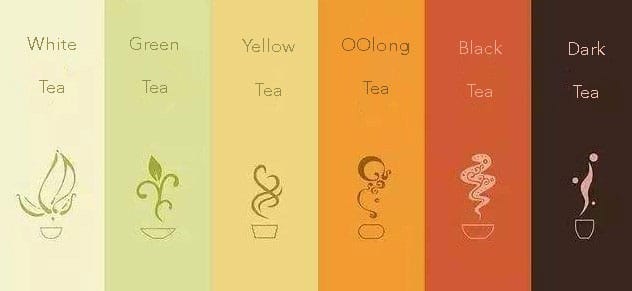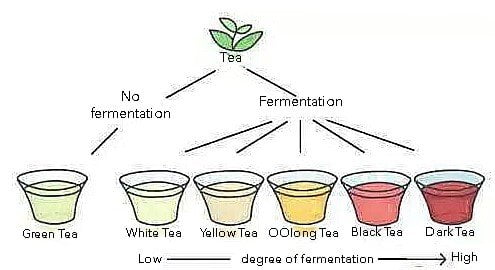
Table of Contents
Actually, it is not too complicated to identify different Chinese teas. The classification system is based on the degree of fermentation. Tea fermentation refers to the enzymatic oxidation of tea leaves over time; this forms theaflavins and thearubigins which make the leaves turn red. In the tea industry, fermentation usually takes place in special rooms where temperature and humidity can be carefully controlled. These factors, as well as the water contained in the leaf itself, all affect the result of the fermentation. It is the percentage of fermentation that actually differentiates the various types of tea: green tea is up to 5 % fermented,normally less; white tea is 5-10% fermented; yellow tea is up to 10% fermented; oolong tea is around 10-60% fermented, black tea 80-85% and dark green tea 100%.


The production processes of the different types of tea are also very different. Green tea undergoes no oxidation process, which is why it retains the natural green colour and fresh taste of the plant. The process of making green tea can be simply divided into three steps: fixation, rolling and drying. Fixation is the first and most important because it determines the quality of the tea. In this process, high temperature is used to destroy the enzymes and bacteria in the fresh leaves, preventing further oxidation. High temperature also evaporates the water inside the leaves, making them soft for rolling. The leaves are then passed through hot and/or cold rollers to establish the shape and intensify the flavour. There are three possible methods for drying: steaming, stir-frying and sunning. Drying the leaves not only removes leftover moisture content and prevents mould growth but also eliminates unpleasant tastes and helps to develop the special tea aroma.
White Tea
Making white tea involves minimal processing. The fresh leaves are simply spread out on a bamboo mat under weak sunlight, or in a well-lit room with good ventilation, and allowed to wither naturally. When the leaves are 70-80% dry, slowly dried by the gentle fire. Slight oxidation takes place gradually throughout the process, so white tea is more oxidised than green tea.
Yellow Tea
Yellow tea is made in a very similar way to green tea; however, it requires a unique additional step called ‘sealed yellowing’. During this step, the tea leaves are wrapped in paper or covered with a wet cloth for several hours. This dramatically reduces the total amount of polyphenol compounds in the leaves, which reduces bitterness. After ‘sealed yellowing’, the yellow tea will be dried slowly and repeat several times.
Oolong Tea
The process of making oolong tea is rather complicated compared with other teas. Oolong tea has a unique and impressive flavour somewhere between black tea and green tea. There are five steps for making it: withering, stirring, stir-fixation, rolling and baking. Withering can take place under natural sunlight or indoors. The next step, stirring, is the key to making oolong tea. The withered leaves are tossed 4-5 times. During this process, the water inside the leaves is evaporated and a series of biochemical changes take place. The leaves then appear as ‘green with a red trim’ and develop a unique flavour. The stir-fixation step then takes place to destroy enzymes in the leaves; it also prevents the leaves from continuing to turn red. The leaf aldehyde, leaf alcohol and hexyl alcohol with low boiling point ingredients will be volatilised. Aromatic substances with high boiling points are then released. The aroma is further matured and purified, producing the elegant and pure aroma of oolong tea. In the next step, the tea is rolled into balls or stripes. It is then baked until the stalks are crisp and can be broken by hand. This step removes redundant water and reduces bitterness, further purifying the aroma. As it is semi-fermented, oolong tea contains less polyphenol than green tea.
Black Tea
Making black tea involves four steps: withering, rolling, fermentation and drying. As with white tea, the leaves are withered naturally. In the rolling process, the cells in the tea are broken down, exposing the polyphenols to oxygen and thus causing enzymatic oxidation. The next step, fermentation, is key for making black tea. The tea leaves are put into a special basket and covered with a cloth that has been soaked in warm water and kept under suitable temperature and humidity for 5–6 hours. The polyphenols and amino acids inside the cells of the leaves undergo enzymatic oxidative reactions, forming a series of oxidation products such as theaflavins, thearubigins and theabrownins. At the same time, other chemical reactions turn the colour of the leaves from green to red. Thus, the unique aroma and colour of black tea are formed. The newly fermented leaves still need to be baked at a temperature of about 80°C (176°F) for around six hours, and then left to cool before they are ready to be packed.
Dark Tea
Making dark green tea involves five steps: fixation, first rolling, piling, second rolling and drying. Fixation uses high temperature to stop the activity of enzymes, preventing the enzymatic oxidation of polyphenols. First, rolling takes place just after fixation while the tea leaves are still hot. Here, the tea is kneaded into strips, which destroys over 20% of the tea cells. The duration of the first rolling is best set at around 15 minutes. Piling is the key procedure for making dark-green tea. The pile of tea leaves should be covered with a wet cloth and placed away from direct sunshine. The pile height should be between 66 and 100 centimetres. The temperature should be kept at around 25 degrees and the relative humidity should be maintained above 85%. The second rolling ensures the tea strips hold more tightly together and further breaks down the tea cells. The second rolling should last around 6–8 minutes. Lastly, the dark green tea is dried by exposure to a pinewood fire, which adds an oily black colour and pine smoke aromas to the tea.




